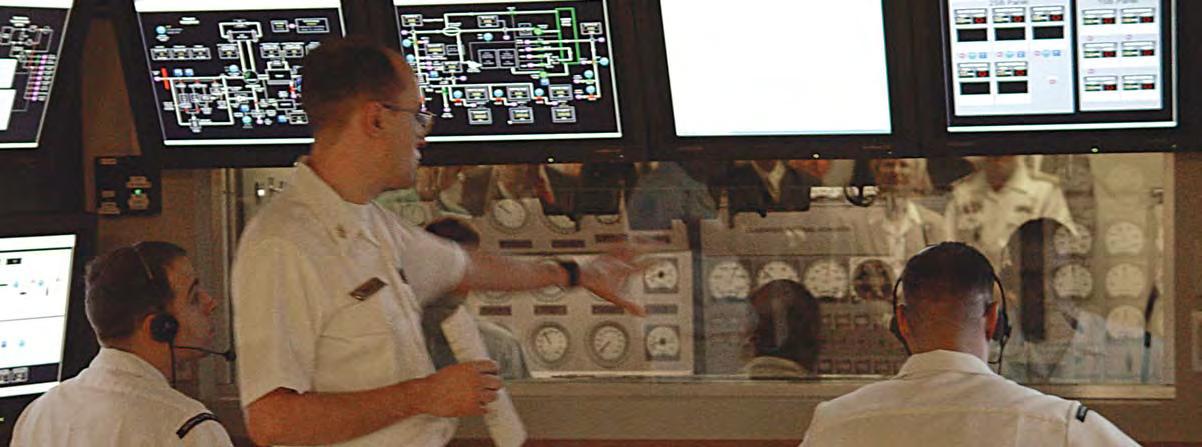
3 minute read
Simulator Brings Realistic Training to Sailors
Trident Training Facility (TTF) Kings Bay unveiled the newest jewel in its training crown on 25 August – the Interactive Display Equipment (IDE) training simulator. TTF is the first facility to receive a Fleet IDE, which replicates the Maneuvering Room aboard a USS Ohio (SSBN-726)-class submarine.
Former VADM Kirk Donald, Commander, Naval Submarine Forces, was on hand for the ceremonial ribbon cutting and dedication, and spoke about the historical importance of the trainer.
Advertisement
“If we expect our Sailors to do their jobs well, we must give them the right tools and the right training,” VADM Donald said. “This trainer accomplishes both of those goals. The Fleet IDE adds another dimension to our already remarkable nuclear training program and harnesses the power of computer technology to improve the effectiveness of our Sailors. This is a great day for the Navy.”
The Fleet IDE is a full-scale and completely interactive trainer that gives operators realistic, intuitive, real-time experience in the normal operations of the ship’s nuclear propulsion plant, as well as simulated casualty situations. Before construction of the simulator, Sailors assigned to nuclear-powered ships could only receive hands-on training onboard the ship. The Fleet IDE gives Sailors another, better option for training.
“The simulator gives us much more flexibility in training,” said Electrician’s Mate 1st Class (SS) Mike Mercer, one of several Fleet IDE instructors. “The Fleet IDE allows us to control every aspect of the scenario and simulate those situations with amazing realism.”
CDR Robert Palsin, Commanding Officer of USS Maine (SSBN-741) (BLUE), echoed Mercer’s sentiments. “There are no limits to our training now,” said Palsin. “We can replicate the feeling and pressures of a real situation on board the submarine. Having this trainer available during our off-crew training period also allows us to train on other things while out to sea. It is an excellent addition to our training program.”
The Fleet IDE fills two rooms – one for the instructors and one for the four-man watch team. A window that separates the rooms gives the instructors a commanding view of the power plant and the actions and reactions of the Sailors training there.
Computer screens also monitor the situation and allow the instructors to program every aspect of simulated casualties.
The Fleet IDE trainer was developed and delivered by the Naval Nuclear Propulsion Program (NNPP) and is the latest innovation in NNPP’s long tradition of commitment to training. The NNPP plans to deliver a Fleet IDE for each major class of nuclear-powered submarines and aircraft carriers to the larger homeports of the ships and crews in upcoming years. Installation of a second Fleet IDE in Bangor, Washington, is scheduled for completion in 2005. The NNPP dedication to excellence through training has resulted in an outstanding safety record. Since 1955, when USS Nautilus (SSN-571) first signaled “underway on nuclear power,” U.S. nuclear-powered warships have collectively steamed more than 130 million miles without a reactor accident.
JO1 Spinner assigned to the Submarine Group 10 Public Affairs Office.
(above) Lead instructor ETCS(SS) James Berhalter explains the new Fleet Interactive Display Equipment training simulator to visitors following the ribbon-cutting ceremony. Behind him, two instructors run the simulator. During a training scenario, the instructors act as the various propulsion plant watch standers and monitor the full range of normal operational and simulated casualty situations. (The computer displays shown here are unclassified mock-ups.)
(below) VADM Kirk Donald, Commander, Naval Submarine Forces, prepares to take the ceremonial chop at the official opening of the Fleet IDE training simulator at the Trident Training Facility in Kings Bay, Georgia. The simulator is the first of its kind in the Navy, and Fleet IDEs for each major class of nuclear-powered submarine and aircraft carrier will be delivered to the larger homeports of the ships and crews in the next few years. Pictured at left is CAPT Larry Davis, Commanding Officer of TTF.
Photos by JO1 Jennifer Spinner, SUBGRU-10 Public Affairs.










